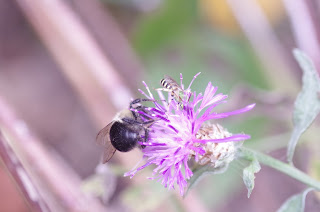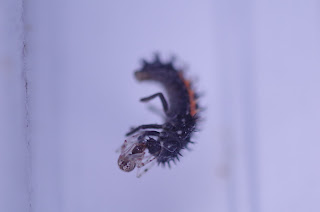Backyard Bug of the Day:
This might be a new bug for me, but I'm not sure. It is some kind of Hemiptera, and appears to be a nymph, so I don't know what it will look like as an adult, maybe I have seen it in that form.
You can see the proboscis, showing that it is a Hemiptera.
It looks like it has a hole in it. I can't tell what's going on there, if it is a hole, or if there is something stuck to it. I almost think maybe it has a parasite? It was still alive, because it was moving.
Ground beetle
Blending in at the edge of a milkweed leaf, a syrphid fly (hover fly) larva.
Just to the left of it here, which I think is the head end, is the remains of an aphid, which is what syrphid fly larvae eat. And what is all over this particular milkweed plant?
Aphids.
Tree cricket, female
Crane fly
Crane fly when it decides it is done having its picture taken.
Sometimes I see little puddles on leaves in my backyard, and I always wonder where they came from (on those occasions when it has not recently rained). Obviously it occurs to me that something relieved itself there, but that never really seems like a good explanation, given that it can be what seems to be too much water for that (and no, I never check to see if it is water). Today I found one of those puddles, and just above it I saw a sharpshooter, which is like a large-ish leaf hoppers (and by large-ish I mean it's about a half inch long. It's not a big bug), and when I spotted it, there was honeydew absolutely fountaining out of its back end. I have seen sharpshooters excrete honeydew before, and it was always just a drop at a time–this thing was spraying. Of course it stopped as soon as I got close with my camera, but I saw enough to see that the liquid was landing on that puddle. But LOOK at how much liquid is there. How in the world could an insect that size have contained that much liquid? Unless it is drinking so much from the plant and it is just going right through its system.
Why is my blog so focused on animal excretions all of a sudden?
Bees can get a bit feisty about sharing flowers, but these two didn't seem to have a problem with it.
In fact, I took the pictures above, and then at least an hour later came back, and...
... more sharing on the same flower. I don't know if it was the exact same two bees, but it was the same species that had been there before.
I have never figured out what kind of flower this is, or what kind of bee this is (Wait, that's not true. I don't know the species, but I think it is a sweat bee of the genus Agapostemon), but this bee likes this flower; most of the times I have seen this species of bee it has been on this species of flower.
I am not sure if this is predation or scavenging. Do ants actually kill other insects, or do they just feed on dead insects that they find? I don't know. I saw this pile of ants on the ground next to the grill, and assumed they were feeding on a bit of food that was dropped while grilling, but looking closer I realized it is a caterpillar.
It looks like a dead moth, but it's just a species that likes to hang out like this for some reason. They come to the porch light a lot. I actually thought maybe this one was dead until I tried to get a different angle on it and bumped the leaf, and it flew away.
Tree cricket, male. I don't know if it's the same species as the one above.
Now, for predation on predators in Arachnid Appreciation:
.
.
.
.
.
.
.
.
.
.
.
.
I was eating breakfast outside at the picnic table when I saw something moving in the grass. Of course I had, for once, decided I didn't have to bring my camera outside with me while I ate, because I didn't expect to see anything to justify juggling my camera and my breakfast on the way out the door, and there it was. I could tell that it was probably two bugs, just because of the shape of the moving object, but when I looked I saw that it was an insect and a spider–and the spider was the prey. The wasp was dragging it through the grass.
I ran inside and got my camera, and I was still pretty easily able to find it, because, well, it was obvious. It was pretty fast, considering what it was doing, but not so fast that it could get away while I was in the house. I know that there are wasps that prey on spiders, and bring them back to their burrows to feed their larvae. I am not sure if the spider in this case is dead or paralyzed–there are a lot of different predatory wasps, so I get them confused. Some of them can fly with their prey, but I guess this one couldn't. I don't know where it went in the end, but I watched it drag this spider over and through the grass for at least ten feet, which is pretty far for something of that size.
At this point the spider got stuck, and the wasp walked around a bit before figuring out another route. One of the interesting things about this is that it walked backwards. I really should have watched it until it got to its burrow, I now realize. Because I have a lot of questions now.
Flower crab spider
This spider has been sitting in this exact same spot for about 2 weeks.
Jumping spider on autumn joy sedum
More predation on predators, only this time the spider is the predator, and a ladybeetle larva is the prey. Of course, ladybeetle larvae feed mostly on aphids, which are basically defenseless (although ants will defend them), so it probably wasn't able to fight off the spider, even given the size difference. The ladybeetle larva was still alive and moving at this point.


































No comments:
Post a Comment